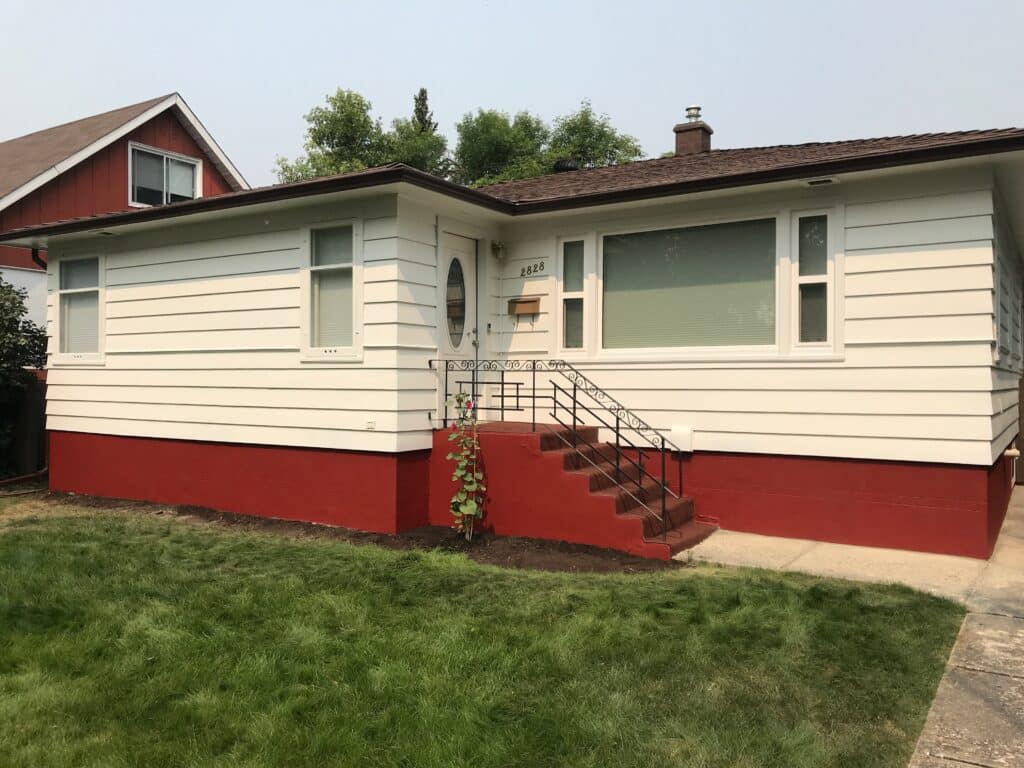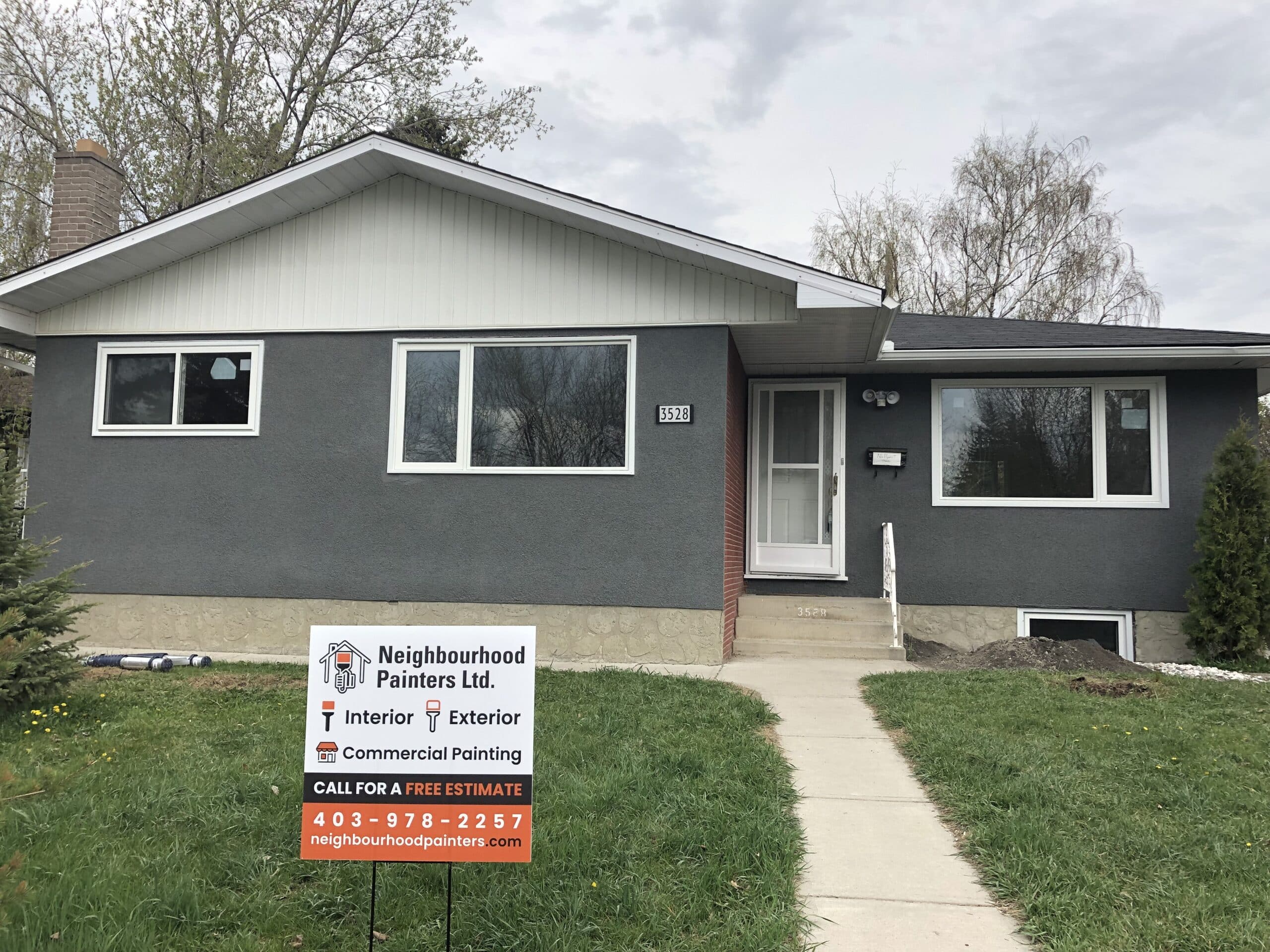Do I really need to prime before painting? It might seem like an unnecessary step, especially if you’re eager to get the job done. But the truth is, skipping primer can result in uneven, patchy paint jobs that deteriorate much sooner than expected.
Can skipping primer save you time and money? Maybe. But it’s often a false economy. Paint-and-primer combos seem like an easy shortcut, but they don’t always provide the protection and coverage that a proper primer can offer. And if you guess wrong, your paint job might fail, leading to costly repairs down the road.
This blog is designed to give you a clear, honest understanding of when primer is absolutely essential for your home’s exterior in Calgary and when you might safely skip it.
Why Primer Matters in Exterior Painting

Primer plays a key role in the exterior painting process. It’s not just an extra coat of paint — it’s an essential foundation that ensures your topcoat adheres properly and stands the test of time. Here’s why primer matters:
-
Seals Porous Surfaces: Surfaces like wood, stucco, and brick are porous, meaning they absorb moisture and paint unevenly. Primer seals these surfaces, creating a smooth, consistent base for your paint.
-
Helps Paint Stick: Primer provides a solid bond between the surface and your topcoat, preventing peeling and cracking down the road.
-
Prevents Stains from Bleeding Through: Wood tannins, rust, mildew, and water stains can bleed through your paint if not sealed properly. Primer blocks these stains from ruining your finished look.
-
Improves Paint Color Accuracy: Without primer, the underlying surface can alter the appearance of your paint. Primer ensures your topcoat appears as intended.
-
Increases the Lifespan of Your Paint Job: By providing a solid base and sealing the surface, primer ensures your paint job lasts longer and looks fresh for years.
Think of it like this: Painting without primer is like frosting a cake without baking it first. The frosting might look fine at first, but it won’t stick, and it definitely won’t last.
Situations Where You MUST Use Primer
Certain conditions make primer a non-negotiable part of your painting project. Skipping it in these cases can result in costly mistakes and a paint job that’s doomed to fail.
Bare or New Surfaces
If you’re painting over raw or unsealed materials, primer is essential. Surfaces like:
-
Raw Wood: Wood is highly absorbent, and without primer, the paint will soak in unevenly, leaving you with a blotchy finish.
-
Bare Stucco, Brick, or Masonry: These materials are porous, meaning they’ll absorb paint and moisture unevenly. Primer helps seal them for a smoother finish.
-
Unsealed Concrete: Concrete is alkaline, and primer helps prevent alkali burn, which can cause your paint to deteriorate prematurely.
Surface Repairs
If you’ve patched holes, sanded, or replaced boards, primer is necessary to ensure the repaired areas blend with the rest of the surface. The new material might absorb paint differently than the rest of the surface, leading to a patchy appearance.
Heavy Staining or Water Damage
If your exterior has visible rust, mildew, tannins, or water stains, primer is a must. It will seal in these stains and prevent them from bleeding through your paint, keeping your finished surface clean and uniform.
Chalky or Peeling Surfaces
If your old paint is chalky, cracked, or peeling, primer will stabilize and bind the surface, making sure your new paint adheres properly and looks smooth.
Dramatic Color Changes
If you’re switching from a dark color to a light one (or vice versa), primer will help prevent the old color from bleeding through and affecting the appearance of your new paint.
When You Might Skip Primer — But Be Careful

There are some situations where you might get away with skipping primer, but there’s a catch — you need to be sure that the surface you’re painting is in good condition. Here’s when skipping primer might be acceptable:
Repainting Good Condition Surfaces
If the existing paint is smooth, intact, and compatible with your new paint, you may be able to skip primer. However, you should still clean the surface thoroughly before painting.
Minimal Color Change
If you’re making a minor color change (e.g., repainting a light blue with a similar light blue), you might not need primer, provided the surface is well-maintained.
High-Quality Paint-and-Primer-in-One
Some high-quality paint-and-primer-in-one products can be effective for clean, previously painted surfaces. However, these should only be used if the surface is in good condition and you’re not making a major color change or painting a porous material.
Important Warning: Skipping primer on the wrong surface can lead to peeling, patchiness, and costly do-overs. Always ensure that the surface you’re painting is in good condition before considering skipping primer.
How Skipping Primer Causes Problems Over Time

Skipping primer can seem like a time-saver initially, but it often leads to problems that will cost you more in the long run. Here’s how skipping primer can hurt your paint job:
Paint Peeling and Flaking
In Calgary’s harsh weather, especially the fluctuating humidity, snow, and sun exposure, paint that’s not properly primed is more likely to peel and flake prematurely. Primer ensures that the paint bonds properly and withstands the elements.
Blotchy, Uneven Paint Finish
Without primer, the surface can absorb the paint unevenly, leading to a blotchy or streaky finish. This is especially true for porous materials like wood or stucco.
Stains Bleeding Through
Stains from rust, water, mildew, and tannins can start to show through your paint over time if you don’t use primer. Primer seals in these stains, preventing them from affecting your paint’s appearance.
Reduced Lifespan of Paint Job
Skipping primer can reduce the lifespan of your paint job by several years. Instead of lasting 7-10 years, your paint may start showing signs of wear after only 3-5 years.
Costly Early Repainting
What might seem like a small cost-saving measure initially could end up doubling or tripling your expenses. You’ll have to repaint sooner, and the cost of removing peeling or damaged paint can add up.
How Professionals Decide If Your Home Needs Primer
Professionals don’t make decisions about primer lightly. Here’s how they assess whether primer is necessary:
- Full Surface Inspection: They carefully inspect the surface for moisture, chalkiness, cracks, and previous paint failures. This step ensures that the primer adheres properly to the surface.
- Moisture Meter Readings: They’ll use a moisture meter to ensure that the wood or masonry is dry enough to accept primer and paint. If the surface is too wet, the paint will not bond correctly.
- Testing Old Paint Adhesion: Professionals may also perform a scratch test or tape test to check the strength of the existing paint. If it’s coming off easily, primer is necessary to ensure proper adhesion of the new paint.
- Choosing the Right Primer Type: Professional painters choose specific primers based on the surface material. For example, oil-based primers for wood or stained surfaces, bonding primers for slick surfaces, and masonry primers for concrete or stucco.
:Types of Exterior Primers and Their Best Uses
Not all primers are created equal. Different types of primer work better on different surfaces. Here’s a breakdown:
| Primer Type | Best For | When to Use |
|---|---|---|
| Oil-Based Primer | Wood, Stained Surfaces, Old Paint | Great for sealing wood, blocking stains, and improving adhesion. |
| Latex-Based Primer | New Wood, Stucco, Concrete, Drywall | Ideal for newer materials, dries quickly, and is eco-friendly. |
| Stain-Blocking Primer | Water, Rust, Tannin Stains | Necessary for surfaces with stains like rust, mildew, or tannins. |
| Bonding Primer | Glossy Surfaces, Metals, Old Paint | Works on hard-to-paint surfaces like metal or glossy finishes. |
Tip: Using the wrong primer — or no primer at all — can lead to paint failure. Make sure to select the right primer for your surface.
Homeowner’s Checklist — Does Your Exterior Need Primer?
Use this checklist to decide if your exterior needs primer before painting:
-
Are you painting bare wood, brick, stucco, or concrete?
-
Are you covering stains, rust, mildew, or water damage?
-
Are you making a major color change (dark to light, or vice versa)?
-
Are you repairing and repainting previously damaged surfaces?
-
Is the old paint chalky, cracked, or peeling?
-
Do you want the new paint to last 7–10+ years?
Conclusion
Primer isn’t always necessary, but when it is, it’s a crucial step for ensuring that your paint job looks great and lasts long. Skipping primer can save you time upfront, but it often leads to bigger problems down the road.
Before you dive into your painting project, make sure you know whether primer is needed. Doing so will save you money and frustration in the long run.
Not sure if your home’s exterior needs primer? Don’t gamble with your biggest investment! Contact [company] for a free consultation and ensure a beautiful, long-lasting paint job the first time around.

